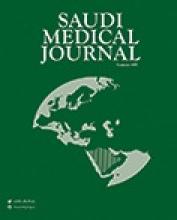Abstract
OBJECTIVE: To describe the epidemiology and clinical features of stroke in a prospective and retrospective cohort of Saudi children and ascertain the causes, pathogenesis, and risk factors.
METHODS: The Retrospective Study Group (RSG) included children with stroke who were evaluated at the Division of Pediatric Neurology, or admitted to King Khalid University Hospital, College of Medicine, King Saud University, Riyadh, Kingdom of Saudi Arabia during the period July 1992 to February 2001. The Prospective Study Group (PSG) included those seen between February 2001 and March 2003.
RESULTS: During the combined study periods of 10 years and 7 months, 117 children (61 males and 56 females, aged one month-12 years) were evaluated; the majority (89%) of these were Saudis. The calculated annual hospital frequency rate of stroke was 27.1/100,000 of the pediatric (1 month-12 years) population. The mean age at onset of the initial stroke in the 104 Saudi children was 27.1 months (SD = 39.3 months) and median was 6 months. Ischemic strokes accounted for the majority of cases (76%). Large-vessel infarcts (LVI, 51.9%) were more common than small-vessel lacunar lesions (SVLL, 19.2%). Five patients (4.8%) had combined LVI and SVLL. Intracranial hemorrhage was less common (18.2%), whereas sinovenous thrombosis was diagnosed in 6 (5.8%) patients. A major risk factor was identified in 94 of 104 (89.4%) Saudi children. Significantly more hematologic disorders and coagulopathies were identified in the PSG compared to the RSG (p=0.001), reflecting a better yield following introduction of more comprehensive hematologic and coagulation laboratory tests during the prospective study period. Hematologic disorders were the most common risk factor (46.2%), presumed perinatal ischemic cerebral injury was a risk factor in 23 children (22.1%) and infectious and inflammatory disorders of the circulatory system in 18 (17.3%). Congenital and genetic cerebrovascular anomalies were the underlying cause in 7 patients (6.7%) and cardiac diseases in 6 (5.8%). Six patients (5.8%) had moyamoya syndrome, which was associated with another disease in all of them. Inherited metabolic disorders (3.8%) included 3 children with Leigh syndrome and a 29-month-old girl with mitochondrial encephalomyopathy, lactic acidosis, and stroke-like episodes. Systemic vascular disease was a risk factor in 3 children (2.9%) including 2 who had hypernatremic dehydration; and post-traumatic arterial dissection was causative in 3 cases (2.9%). Several patients had multiple risk factors, whereas no risk factor could be identified in 11 (10.6%).
CONCLUSION: Due to the high prevalence and importance of multiple risk factors, a comprehensive investigation, including hematologic, neuroimaging and metabolic studies should be considered in every child with stroke.
- Copyright: © Saudi Medical Journal
This is an open-access article distributed under the terms of the Creative Commons Attribution-Noncommercial License (CC BY-NC), which permits unrestricted use, distribution, and reproduction in any medium, provided the original work is properly cited.






